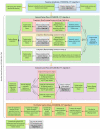Optimizing Image Classification: Automated Deep Learning Architecture Crafting with Network and Learning Hyperparameter Tuning
- PMID: 37999166
- PMCID: PMC10669013
- DOI: 10.3390/biomimetics8070525
Optimizing Image Classification: Automated Deep Learning Architecture Crafting with Network and Learning Hyperparameter Tuning
Abstract
This study introduces ETLBOCBL-CNN, an automated approach for optimizing convolutional neural network (CNN) architectures to address classification tasks of varying complexities. ETLBOCBL-CNN employs an effective encoding scheme to optimize network and learning hyperparameters, enabling the discovery of innovative CNN structures. To enhance the search process, it incorporates a competency-based learning concept inspired by mixed-ability classrooms during the teacher phase. This categorizes learners into competency-based groups, guiding each learner's search process by utilizing the knowledge of the predominant peers, the teacher solution, and the population mean. This approach fosters diversity within the population and promotes the discovery of innovative network architectures. During the learner phase, ETLBOCBL-CNN integrates a stochastic peer interaction scheme that encourages collaborative learning among learners, enhancing the optimization of CNN architectures. To preserve valuable network information and promote long-term population quality improvement, ETLBOCBL-CNN introduces a tri-criterion selection scheme that considers fitness, diversity, and learners' improvement rates. The performance of ETLBOCBL-CNN is evaluated on nine different image datasets and compared to state-of-the-art methods. Notably, ELTLBOCBL-CNN achieves outstanding accuracies on various datasets, including MNIST (99.72%), MNIST-RD (96.67%), MNIST-RB (98.28%), MNIST-BI (97.22%), MNST-RD + BI (83.45%), Rectangles (99.99%), Rectangles-I (97.41%), Convex (98.35%), and MNIST-Fashion (93.70%). These results highlight the remarkable classification accuracy of ETLBOCBL-CNN, underscoring its potential for advancing smart device infrastructure development.
Keywords: automatic network design; deep learning architecture; hyperparameter optimization; image classification; teaching–learning-based optimization.
Conflict of interest statement
The authors declare no conflict of interest.
Figures











References
-
- Wang P., Li Z., Hou Y., Li W. Action recognition based on joint trajectory maps using convolutional neural networks; Proceedings of the 24th ACM International Conference on Multimedia; Amsterdam, The Netherlands. 15–19 October 2016; pp. 102–106.
-
- Jayanthi J., Jayasankar T., Krishnaraj N., Prakash N., Sagai Francis Britto A., Vinoth Kumar K. An intelligent particle swarm optimization with convolutional neural network for diabetic retinopathy classification model. J. Med. Imaging Health Inform. 2021;11:803–809. doi: 10.1166/jmihi.2021.3362. - DOI
-
- Müller A., Karathanasopoulos N., Roth C.C., Mohr D. Machine learning classifiers for surface crack detection in fracture experiments. Int. J. Mech. Sci. 2021;209:106698. doi: 10.1016/j.ijmecsci.2021.106698. - DOI
LinkOut - more resources
Full Text Sources
Miscellaneous

